View in other NatureServe Network Field Guides
NatureServe
Montana
Utah
Wyoming
Idaho
Wisconsin
British Columbia
South Carolina
Yukon
California
New York
Chocolate Arion Slug - Arion rufus
Other Names:
Arion ater, Limax rufus
General Description
A very large slug, reaching 150 mm or more when extended, although many individuals are smaller. Dorsal base color is various shades of black (the typical color), brown, or orange, juveniles more variable than adults; generally lacking dorsal patterning (bands, stripes, spots). The mantle is the same color as the tail and covers about 1/3 of the body. The pneumostome is in the anterior half of the mantle margin on the right side, posterior to the mantle cleft. The tail lacks a keel but is covered dorsally by many irregular, coarse and long tubercles arranged in many oblique rows. The sole is pale and undivided (lacking two longitudinal furrows); the mucous is clear (McDonnell et al. 2009, Hendricks 2012, Burke 2013). Internal anatomy is described by Pilsbry (1948) and Forsyth (2004).
Diagnostic Characteristics
Arion lack an elevated visceral hump, possess a mantle about 1/3 the length of the animal with the pneumostome in the anterior half of the mantle, have an undivided foot, lack a dorsal keel on the tail, have a relatively broad tail covered with rows of prominent turbercles and with a caudal mucous pit at the tip where the pedal furrows meet. A. rufus differs from other members of the genus by a combination of it's very large size, black color (although rusty red and brown forms found in other states), lack of bands on mantle and tail, and production of a clear mucous.
Species Range
Montana Range
Range Descriptions
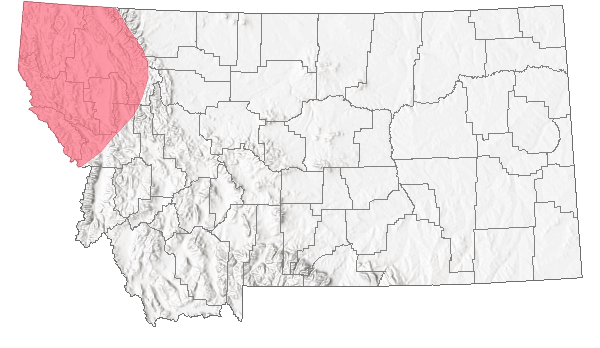
 Non-native
Non-native
Range Comments
Native to western and central Europe; introduced in many other regions worldwide, including the Americas (Burke 2013). In Montana, reported from just a few areas west of the Continental Divide, in Flathead, Glacier, Lake, and Sanders counties. Elevation range is 672 to 1158 m (2205 to 3800 ft). All Montana reports are of the black form. May be locally abundant; several hundred were reported at one Flathead County site in early July, including individuals to 100 mm or more in length. Its full distribution is probably underrepresented by recent surveys (Hendricks 2012).
Observations in Montana Natural Heritage Program Database
Number of Observations: 41
(Click on the following maps and charts to see full sized version)
Map Help and Descriptions
Relative Density
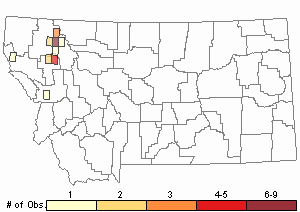
Recency

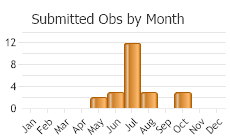
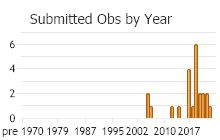
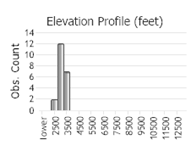 (Observations spanning multiple months or years are excluded from time charts)
(Observations spanning multiple months or years are excluded from time charts)
Habitat
Occupies moist to wet sites (stream-sides, fens, marshy areas) within forested or shrubby locations, usually near areas of human activity, such as campgrounds and residences. Canopy species include western redcedar, western larch, Douglas-fir, paper and water birch, and black cottonwood; secondary canopy species include willow and dogwood (Hendricks 2012).
Stewardship Responsibility
References
- Literature Cited AboveLegend:
 View Online Publication
View Online Publication Burke, T. E. 2013. Land snails and slugs of the Pacific Northwest. Corvallis, OR: Oregon State University Press. 344 p.
Burke, T. E. 2013. Land snails and slugs of the Pacific Northwest. Corvallis, OR: Oregon State University Press. 344 p. Forsyth, R.G. 2004. Land snails of British Columbia. Royal British Columbia Museum: Victoria, British Columbia, Canada. 188 pp.
Forsyth, R.G. 2004. Land snails of British Columbia. Royal British Columbia Museum: Victoria, British Columbia, Canada. 188 pp. Hendricks, P. 2012. A Guide to the Land Snails and Slugs of Montana. A report to the U.S. Forest Service - Region 1. Montana Natural Heritage Program, Helena, MT. vii + 187 pp. plus appendices.
Hendricks, P. 2012. A Guide to the Land Snails and Slugs of Montana. A report to the U.S. Forest Service - Region 1. Montana Natural Heritage Program, Helena, MT. vii + 187 pp. plus appendices. McDonnell, R. J., T. D. Paine, and M. J. Gormally. 2009. Slugs, a guide to the invasive and native fauna of California. University of California Division of Agriculture and Natural Resources Publication 8336. 21 p.
McDonnell, R. J., T. D. Paine, and M. J. Gormally. 2009. Slugs, a guide to the invasive and native fauna of California. University of California Division of Agriculture and Natural Resources Publication 8336. 21 p. Pilsbry, H.A. 1948. Land Mollusca of North America (north of Mexico), Volume II Part 2. The Academy of Natural Sciences of Philadelphia Monograph Number 2(2): 521-1113.
Pilsbry, H.A. 1948. Land Mollusca of North America (north of Mexico), Volume II Part 2. The Academy of Natural Sciences of Philadelphia Monograph Number 2(2): 521-1113.
- Additional ReferencesLegend:
 View Online Publication
View Online Publication
Do you know of a citation we're missing? Frest, T.J. and E.J. Johannes. 2001. An annotated checklist of Idaho land and freshwater mollusks. Journal of the Idaho Academy of Science 36(2):1-51.
Frest, T.J. and E.J. Johannes. 2001. An annotated checklist of Idaho land and freshwater mollusks. Journal of the Idaho Academy of Science 36(2):1-51. Grimm, F.W., R.G. Forsyth, F.W. Schueler, and A. Karstad. 2009. Identifying land snails and slugs in Canada: introduced species and native genera. Canadian Food Inspection Agency, Ottawa, ON. 168 pp.
Grimm, F.W., R.G. Forsyth, F.W. Schueler, and A. Karstad. 2009. Identifying land snails and slugs in Canada: introduced species and native genera. Canadian Food Inspection Agency, Ottawa, ON. 168 pp.
- Web Search Engines for Articles on "Chocolate Arion Slug"
- Additional Sources of Information Related to "Snails / Slugs"





